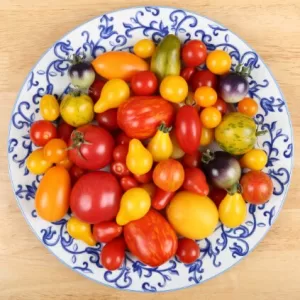The Tomato: A Global Culinary Icon and Nutritional Powerhouse

The Origins and Historical Journey of the Tomato
The tomato, often revered as the red jewel of the kitchen, has a remarkable story that transcends continents and culinary traditions
Native to the Americas, the tomato was first cultivated in the rich soils of Mexico. It was here that the Aztecs and other Mesoamerican cultures began to domesticate this vibrant fruit, using it as a cornerstone of their diet long before it found its way across the Atlantic.
When the tomato was introduced to Europe in the 16th century, it was initially met with suspicion and thought to be poisonous. Despite these early misconceptions, the tomato captured the imagination of European chefs and quickly became a staple in Mediterranean cuisine. In Italy, it earned the affectionate name “pomo d’oro,” or “golden apple,” highlighting the early varieties that boasted a luminous yellow hue and emphasizing its newfound culinary value akin to gold.
Varieties and Culinary Versatility
The diversity of the tomato is one of its greatest strengths, with each variety offering a unique set of flavors, textures, and culinary possibilities. From robust beefsteaks to tiny, sweet cherry tomatoes, these varieties have conquered kitchens around the world.

Exploring Tomato Varieties
- Beefsteak Tomatoes: Known for their large size and juicy texture, beefsteak tomatoes are ideal for sandwiches and salads, where their balanced flavor can truly shine.
- Cherry Tomatoes: These small, vibrant tomatoes are perfect for snacking, tossing into salads, or adding a burst of color and flavor to baked dishes.
- Roma Tomatoes: Also known as plum tomatoes, these are less watery with fewer seeds, making them the go-to choice for sauces and preserves.
- Heirloom Tomatoes: Celebrated for their diverse shapes, colors, and flavors, heirloom tomatoes add depth and uniqueness to any dish.
- Grape Tomatoes: Sweeter and firmer than cherry tomatoes, grape tomatoes are a popular addition to salads or enjoyed as a healthy snack.
- San Marzano Tomatoes: Hailing from Italy, these tomatoes are renowned for their dense flesh and rich, sweet flavor, making them the gold standard for tomato sauces.
- Green Zebra Tomatoes: With green skin adorned with yellow stripes, these tomatoes provide a slightly tart flavor perfect for salads and cold dishes.
- Yellow Tomatoes: Known for their gentle sweetness and lower acidity, yellow tomatoes are a delightful addition to any culinary creation.
- Purple/Black Tomatoes: Offering deep colors and a smoky flavor, these tomatoes bring complexity and richness to dishes.
- Oxheart Tomatoes: Resembling a heart in shape, oxheart tomatoes are large with an intense flavor profile.
- Orange Tomatoes: These offer a delicious option for those seeking a tomato variety with lower acidity.
- White Tomatoes: With their mild flavor, white tomatoes offer a unique surprise and can add visual interest to dishes.
The Significance of Tomato Colors

The vibrant colors of tomatoes do more than just catch the eye; they provide insights into their flavor profiles and nutritional content. Red tomatoes typically balance sweetness and acidity, while yellow and orange varieties are sweeter and less acidic. Purple and black tomatoes often deliver a smoky or earthy taste.
The color also reflects the different phytonutrients present. For example, orange and yellow tomatoes are high in beta-carotene, while purple and black varieties are rich in anthocyanins, both offering various health benefits.
Nutritional Benefits of Tomatoes
Tomatoes are a nutritional powerhouse, rich in essential vitamins and minerals. They are an excellent source of vitamin C, which supports the immune system, and vitamin K, which is vital for bone health and blood clotting. Tomatoes also provide potassium, important for heart health and folate, crucial for cell function.
One of the most celebrated compounds in tomatoes is lycopene, a powerful antioxidant. Research suggests that lycopene may play a role in reducing the risk of heart disease and certain types of cancer, making tomatoes not only a culinary delight but also a health-promoting food.
Culinary Uses and Global Influence
The versatility of tomatoes is apparent in their widespread use across global cuisines. In Italian cooking, tomatoes are the foundation of many sauces and dishes, from the classic Caprese salad to the rich ragù. In Mexico, they are essential in salsas and stews, while in India, they add depth to curries and chutneys.
Tomatoes are also celebrated in modern gastronomy for their ability to pair with a variety of ingredients. They complement flavors such as basil, garlic, and olive oil, enhancing everything from simple bruschetta to complex gourmet creations.
Conclusion
The tomato, with its myriad varieties and vibrant colors, stands as a testament to its unparalleled versatility and nutritional value. It continues to be a beloved ingredient that enriches kitchens and dining tables worldwide. By exploring the diverse world of tomatoes, we not only expand our culinary horizons but also embrace a healthier lifestyle. This humble fruit, once misunderstood, now shines as a pillar of global gastronomy, offering a feast for both the senses and the body.
Through understanding and appreciating the wealth of tomato varieties, we celebrate a fruit that transforms each dish into a work of art, nourishing us in both body and spirit. Embrace the tomato’s bounty and let it inspire your next culinary adventure.
